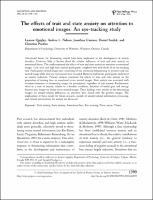Please use this identifier to cite or link to this item:
https://hdl.handle.net/20.500.12202/9676| Title: | The effects of trait and state anxiety on attention to emotional images: An eye-tracking study |
| Authors: | Quigley, Leanne Nelson, Andrea L. Carriere, Jonathan Smilek, Daniel Purdon, Christine 0000-0002-3676-4083 |
| Keywords: | Tracking (Psychology) Personality Anxiety disorders attention emotions Attentional bias Eye tracking State anxiety Threat (psychology) Time course Trait anxiety |
| Issue Date: | 2012 |
| Publisher: | Taylor & Francis |
| Citation: | Quigley, L., Nelson, A., Carriere, J., Smilek, D., & Purdon, C. (2012). The effects of trait and state anxiety on attention to emotional images: An eye-tracking study. Cognition & Emotion, 26(8), 1390–1411. https://doi.org/10.1080/02699931.2012.662892 |
| Series/Report no.: | Cognition & Emotion;26(8) |
| Abstract: | Attentional biases for threatening stimuli have been implicated in the development of anxiety disorders. However, little is known about the relative influences of trait and state anxiety on attentional biases. This study examined the effects of trait and state anxiety on attention to emotional images. Low, mid, and high trait anxious participants completed two trial blocks of an eye-tracking task. Participants viewed image pairs consisting of one emotional (threatening or positive) and one neutral image while their eye movements were recorded. Between trial blocks, participants underwent an anxiety induction. Primary analyses examined the effects of trait and state anxiety on the proportion of viewing time on emotional versus neutral images. State anxiety was associated with increased attention to threatening images for participants, regardless of trait anxiety. Furthermore, when in a state of anxiety, relative to a baseline condition, durations of initial gaze and average fixation were longer on threat versus neutral images. These findings were specific to the threatening images; no anxiety-related differences in attention were found with the positive images. The implications of these results for future research, models of anxiety-related information processing, and clinical interventions for anxiety are discussed. [ABSTRACT FROM AUTHOR] Copyright of Cognition & Emotion is the property of Taylor & Francis Ltd and its content may not be copied or emailed to multiple sites or posted to a listserv without the copyright holder's express written permission. However, users may print, download, or email articles for individual use. This abstract may be abridged. No warranty is given about the accuracy of the copy. Users should refer to the original published version of the material for the full abstract. (Copyright applies to all Abstracts.) |
| Description: | Scholarly article / Open access |
| URI: | https://hdl.handle.net/20.500.12202/9676 |
| ISSN: | 0269-9931 |
| Appears in Collections: | Ferkauf Graduate School of Psychology: Faculty Publications |
Files in This Item:
| File | Description | Size | Format | |
|---|---|---|---|---|
| Quigley 2012 OA StateandTraitonattention.pdf | 269.15 kB | Adobe PDF |  View/Open |
This item is licensed under a Creative Commons License

